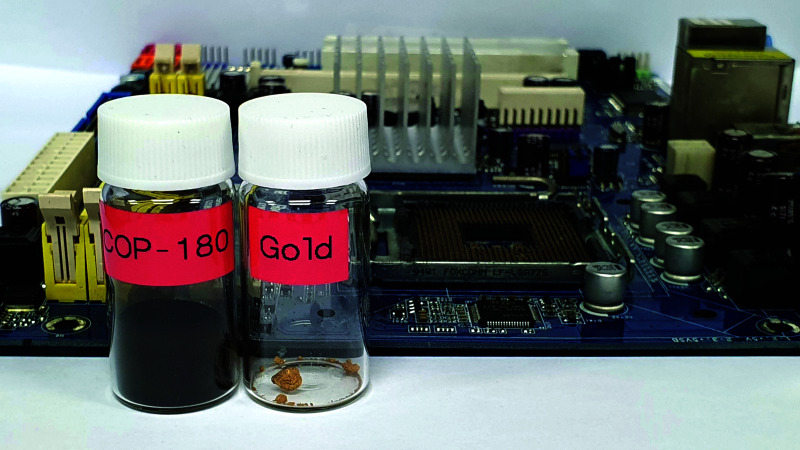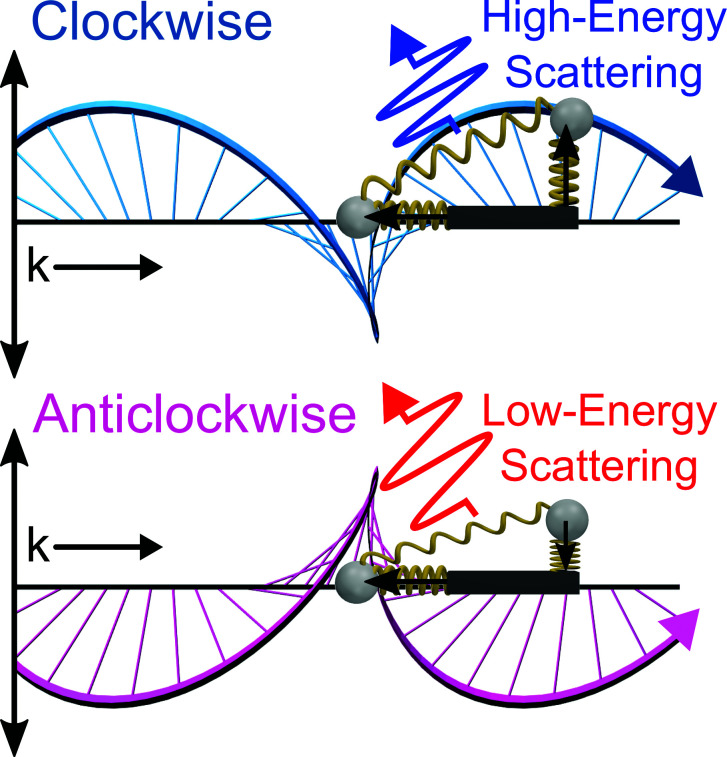Origins of lead glassmaking in Spain
Aerial view of the excavation area of the Rabad of Šaqunda with the Aljama Mosque of Córdoba, Spain, in the background. Image credit: Municipal Planning Department of Córdoba—University of Córdoba.
Before the eighth century, glassmaking centers on the Levantine coast and in Egypt supplied the Mediterranean with glass produced from a mixture of sand and mineral soda. Declining imports of raw glass to the western Mediterranean led to increased glass recycling and, ultimately, the development of new glassmaking traditions, both in Carolingian Europe and the Islamic world. However, the origins of medieval glassmaking in Spain remain unclear. Using mass spectrometry and isotopic analyses, Nadine Schibille et al. (pp. 16243–16249) examined glass fragments from the Rabad of Šaqunda in Córdoba, the capital of Umayyad Spain. Dated between the middle of the eighth century and the first quarter of the ninth century, the glass assemblage included recycled natron-type glass from Egypt and the Levant as well as plant-ash glass from Mesopotamia, demonstrating long-distance acquisition of glass objects. Furthermore, several samples contained high levels of lead and were created locally, using material from nearby ore deposits. The findings suggest that lead glass production developed in Spain and predates the introduction of Islamic lead-glazed ceramics in Iberia by more than 50 years, according to the authors. — M.S.
Mining electronic waste for precious metals
Porous porphyrin polymer (COP-180) can extract gold from a computer circuit board and produce pure gold nuggets.
Used circuit boards, screens, and other electronic waste contain precious metals, such as gold and palladium. However, most electronic waste ends up in landfills owing to a lack of safe and efficient methods to recover ores. Yeongran Hong et al. (pp. 16174–16180) report the synthesis of a porphyrin polymer (COP-180) that captures precious metals from chemically digested electronic waste, raising the possibility that an industrial hazard could become a sustainable source of precious metals. Porphyrins are molecules with ring structures with a high affinity for binding transition metals, such as precious metals, in their center. The authors synthesized the polymer COP-180 by linking porphyrin rings. Using standardized test solutions, the authors showed that COP-180 takes up platinum at the expected rate, whereas gold is adsorbed at a rate 10 times higher than expected. The authors ascribe the increased efficiency to reductive adsorption, which allows the gold atoms to cluster in crystals. To further test COP-180, the authors collected circuit boards at a local outlet for electronic waste. After digesting the boards with an acidic solution, the authors added COP-180, finding that the polymer captured the gold with 94% efficiency. According to the authors, the gold captured by $5 worth of COP-180 would be worth an estimated $64, with profit margins expected to increase when the polymer is reused. — T.H.D.
Interaction reveals sensitivity of matter to trochoidal polarization
Coupled dipole scatterers, shown as coupled springs, interact differently with clockwise and anticlockwise trochoidal waves.
Technologies such as liquid crystal displays and 3D glasses exploit the ability of matter to interact differently with different polarizations of light. Although light can acquire numerous forms of polarization, most applications are built on linear or circular polarizations, in which the wave motion is constrained to a plane or helix, respectively. Lauren McCarthy et al. (pp. 16143–16148) describe a novel light–matter interaction that occurs between trochoidal polarizations—a combination of planar and rotational motions that produces a cartwheeling wave motion—and a model metamaterial system containing coupled dipole scatterers. The authors demonstrate that single gold nanorod dimers can differentiate between trochoidal fields rotating in opposite directions and term the phenomenon “trochoidal dichroism.” The nomenclature draws on a technique called circular dichroism, which characterizes interactions between circularly polarized light and biomolecules. The study reveals that matter can be inherently sensitive to the direction of the trochoidal field, and the authors suggest that trochoidal dichroism can be used to probe molecular rotational symmetries at interfaces. — T.J.
Predicting human mortality using nonbiological factors
Numerous biological and nonbiological factors influence human mortality risk. To pinpoint nonbiological factors with significant public health and policy implications, Eli Puterman et al. (pp. 16273–16282) examined 57 factors related to six domains: adverse socioeconomic and psychosocial experiences during childhood, adverse experiences during adulthood, health behaviors, psychological characteristics, social connections, and socioeconomic conditions. The authors examined survey data of 13,611 adults aged 52–104 years. The data were compiled by the US Health and Retirement Study between 1992 and 2008 and included 6 years of follow-up to determine mortality. Predictors of mortality spanned all six domains, but the strongest predictors included smoking, alcohol abuse, lack of physical activity, financial difficulties, unemployment history, low life satisfaction, and negative social experiences, such as divorce and frequent discrimination. The predictive strength did not significantly differ based on gender. The findings highlight the importance of including behavioral, psychological, and social factors into mortality risk assessments. Such factors should be considered in creating health policy and interventions, according to the authors. — M.S.
Dystrophin reduction in Duchenne muscular dystrophy
Duchenne muscular dystrophy (DMD) is caused by mutations in the DMD gene that result in premature termination codons (PTCs) and a lack of functional dystrophin protein. PTCs can lead to greatly reduced dystrophin mRNA transcript levels in muscle, but it is unclear whether this reduction is attributable to nonsense-mediated decay (NMD), the cytoplasmic surveillance mechanism that degrades mRNAs when PTCs are detected. Using in situ hybridization, Raquel Garcia-Rodriguez et al. (pp. 16456–16464) found that dystrophin mRNA primarily localizes to the nuclear compartment of skeletal muscle fibers, suggesting that NMD is not the primary mechanism underlying reduced dystrophin transcript levels. Sequencing of nascent RNA revealed reduced transcriptional output at the DMD locus in the presence of PTC. Chromatin immunoprecipitation in muscle revealed increased levels of the transcriptionally repressive H3K9me3 modification along the Dmd locus in mdx mice, which carry a nonsense mutation in Dmd, compared with wild-type mice. The latter finding suggests that the chromatin conformation in mdx mice may be less prone to transcription than that of wild-type mice. In addition, treating mdx mice with the histone deacetylase inhibitor givinostat resulted in a significant increase in DMD transcript expression compared with placebo-treated mice. The authors suggest that the results support a potential epigenetic mechanism for the reduced dystrophin levels observed in the presence of PTC. — S.R.
Oxygen evolution catalysts in acid-stable frameworks
For solar energy to be widely adopted, incoming solar radiation must be efficiently and inexpensively converted to stored energy. One promising strategy uses the Sun’s energy to electrolyze water into oxygen and hydrogen gas, the latter of which is a highly combustible and relatively clean-burning fuel. Nancy Li et al. (pp. 16187–16192) explored a technical challenge facing solar-powered electrolysis: acid-stable, Earth-abundant oxygen evolution catalysts (OECs). OECs help facilitate the kinetically demanding portion of water splitting, namely the oxygen evolution reaction. However, most OECs break down immediately under the acidic environments of hydrolysis. Although some corrosion-resistant OECs have been developed, they require costly rare metals or exhibit low activity. The authors developed a system for acid-stable OECs that embeds Earth-abundant metal oxide sites within acid-resistant NiFePbOx or NiPbOx films. The system exploits electrochemical potentials to offset corrosion and extend the catalytic lifespan of the metal oxides. According to the authors, OECs constructed in this manner can remain stable and yield highly active oxygen evolution reactions for more than 20 hours in acidic solutions. — T.J.
Nicotinic receptors and neonicotinoid action
Neonicotinoid insecticides—a family of substances that act selectively on insect nicotinic acetylcholine receptors (nAChRs)—have been widely used to protect crops and livestock from harmful pests. Mounting evidence suggests that neonicotinoids may be harmful to beneficial insects, such as bees, and efforts to functionally express insect nAChRs could help investigate how the insecticides affect pollinators. Makoto Ihara et al. (pp. 16283–16291) report that thioredoxin-related transmembrane protein 3 is a key cofactor that enables the robust expression in African clawed frog (Xenopus laevis) oocytes of functional nAChRs from the western honeybee, buff-tailed bumblebee, and fruit fly. The authors used functional expression of the receptors to describe picomolar target site actions of neonicotinoids in the western honeybee and the buff-tailed bumblebee. The authors found that nAChRs in these species are particularly sensitive to neonicotinoids, with some compounds acting at concentrations far below those typically found in agricultural fields. According to the authors, even sublethal, chronic exposure to neonicotinoids may alter critical behaviors in bees and contribute to widespread population declines. — T.J.





